Costa Rica is renowned for its lush rainforests, stunning beaches, and diverse wildlife. But what often goes unsung is its delectable cuisine, which is where this guide to typical and traditional Costa Rican food comes in.
A true reflection of the country’s rich culture and history, Costa Rican food is a delightful fusion of indigenous, Spanish, and Afro-Caribbean influences. Join us on a virtual mouthwatering journey through the typical dishes and flavors that define Costa Rican gastronomy.
The Diverse Flavors of Central American Cuisine
As in most Central American countries, the flavors vary from city to city, so you can look forward to trying regional twists on classic dishes depending on your destination. While we can’t list every item you’ll see on the menu in Costa Rica, we’ve rounded up some of our favorites!
Costa Rica Waterfall Tours is located in Jaco, southwest of the capital city, San José. Famed for its beautiful natural scenery, Jaco’s waterfall tours and canyoning tours make it a coastal haven for fresh seafood to fuel your outdoor adventures!
But don’t just take our word for it, discover this idyllic Costa Rican spot for yourself. Whether you’re looking to see the country on an adventure tour or travel via your tastebuds, Costa Rica Waterfall Tours has everything from Jaco accommodation to Jaco Beach natural wonder tours.
If natural swimming holes, pools, and waterfalls sound like your idea of fun, just get in touch to learn more! Until then, let’s answer the question: what is a typical meal in Costa Rica?
Traditional Costa Rican Dishes You Have to Try
Enjoy Gallo Pinto — a Costa Rican Staple
Gallo Pinto is the heart and soul of Costa Rican cuisine. It’s a simple dish made from white rice and black/red beans, sautéed together with bell peppers, onions, and cilantro. This combination forms the foundation of nearly every Costa Rican meal.
Whether you’re enjoying it for breakfast, lunch, or dinner, Gallo Pinto is a must-try and a true representation of the country’s food culture.
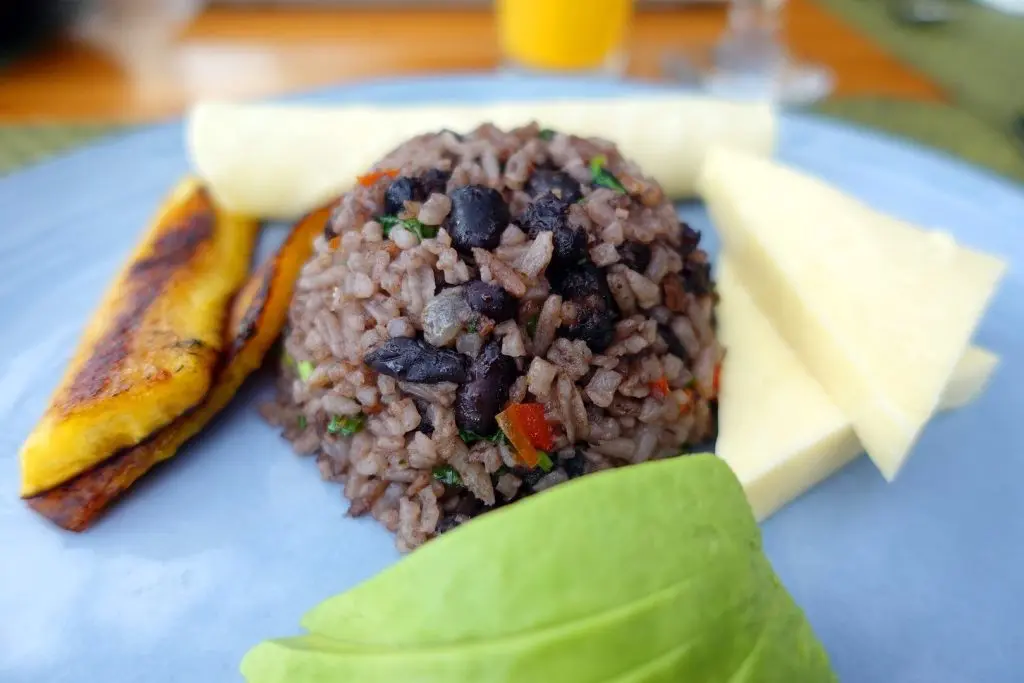
Try Casado – a Full Costa Rican Meal
If you’re looking for a well-rounded Costa Rican meal, order a Casado. This dish offers a generous serving of Gallo Pinto, complemented by a protein source such as grilled chicken, fish, or pork.
It also includes a side of salad, fried plantains (maduros), and often, a small helping of picadillo (a sweet and savory vegetable hash). Casado means “married” in Spanish, as this dish marries a variety of flavors and textures into one satisfying plate.
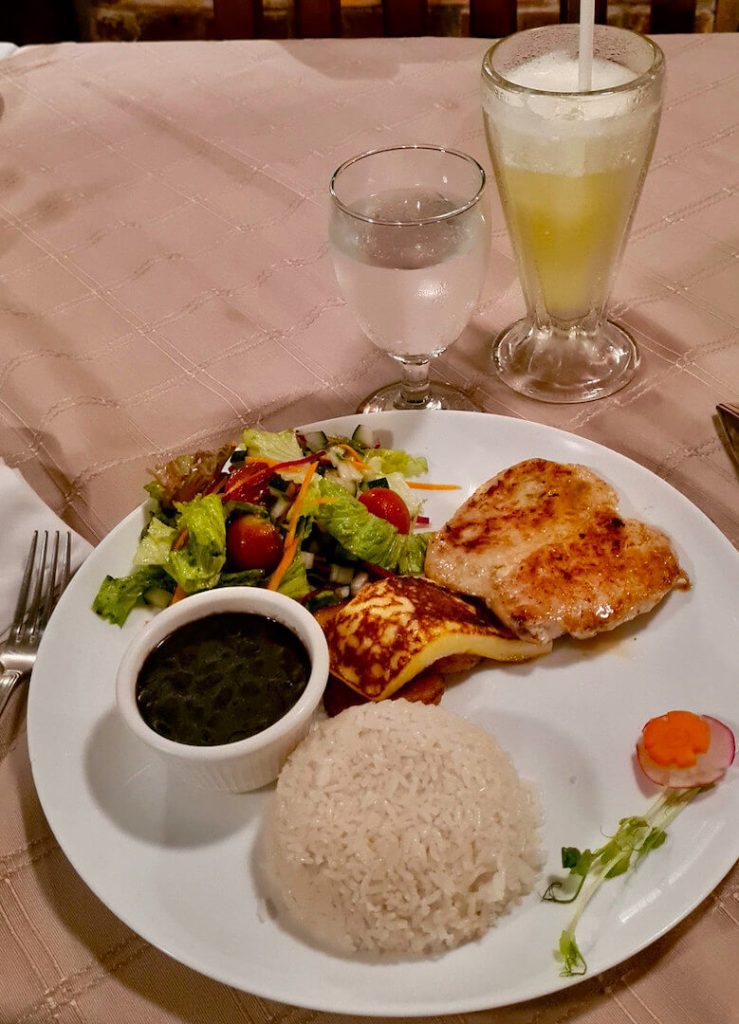
Discover Ceviche – a Taste of the Sea
Costa Rica’s coastal location means an abundance of fresh seafood, and ceviche is a delightful way to savor it. Ceviche in Costa Rica is typically made with diced white fish or shrimp, marinated in lime juice and mixed with finely chopped onions, bell peppers, and cilantro.
The acidity of the lime “cooks” the seafood, resulting in a refreshing and zesty dish that’s perfect for warm Costa Rican days.

Taste Tamales – Wrapped Costa Rican Goodness
Tamales are a cherished part of Costa Rican cuisine, especially during the holiday season. These steamed corn dough parcels are filled with a savory mixture of meats, vegetables, and spices, all wrapped in banana leaves.
Tamales come in various regional variations, making them a versatile treat enjoyed throughout the country. Whether you prefer them with pork, chicken, or even sweet fillings like raisins and rice pudding, Tamales are a delightful and hearty choice.
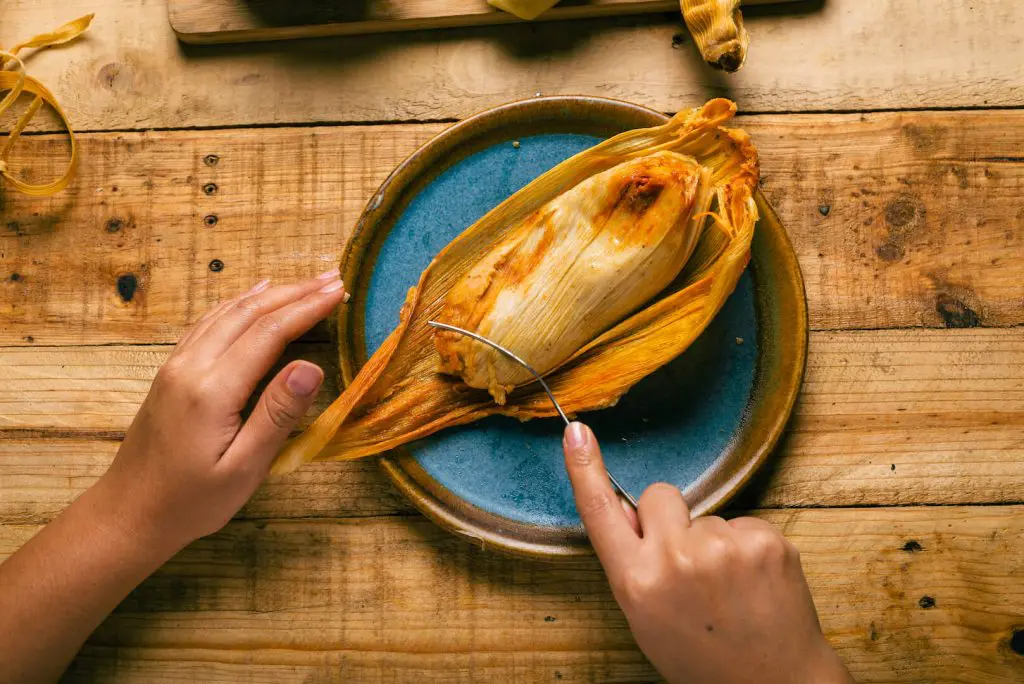
Savour Plantains – a Versatile Costa Rican Staple
Plantains are a beloved ingredient in Costa Rican cooking and can be found in various forms throughout the cuisine. Patacones are twice-fried plantain slices, often served as a side or a snack, while maduros are ripe plantains fried to a sweet and tender perfection.
Additionally, plantains are sometimes mashed into tostones and served as a crispy accompaniment to main dishes. These versatile fruits add a touch of sweetness and texture to Costa Rican meals.
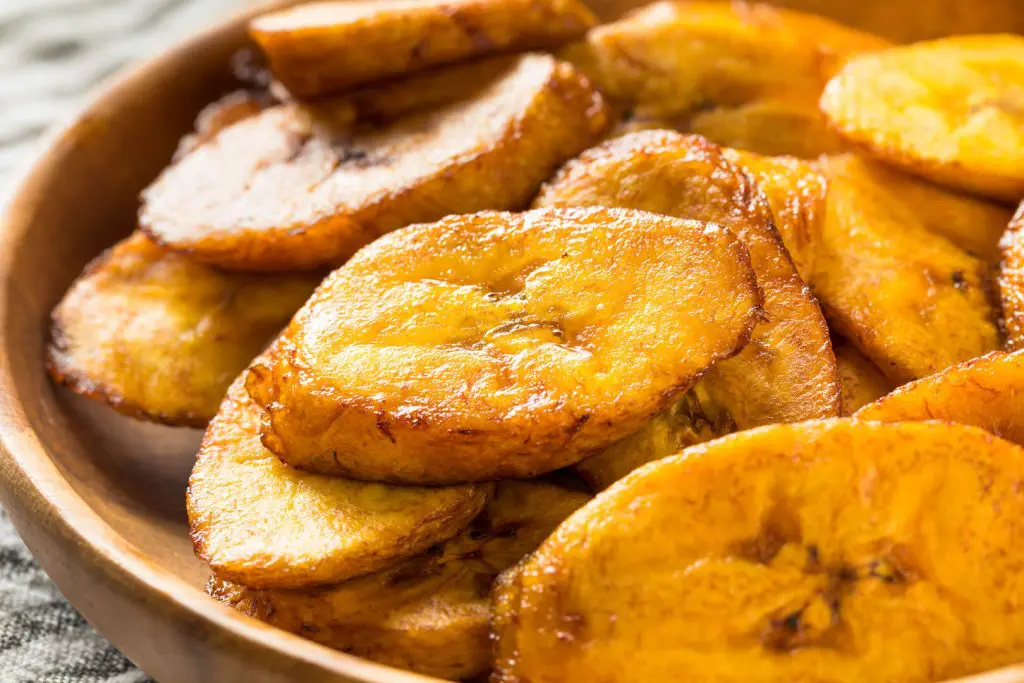
Warm Up with Costa Rican Pozole
Costa Rican Pozole, a delightful variation of the traditional Mexican dish, showcases the country’s unique culinary identity. This hearty soup consists of hominy corn kernels simmered in a flavorful broth, often enriched with tender cuts of pork or chicken.
What sets Costa Rican Pozole apart is the addition of achiote, a vibrant red spice derived from annatto seeds, which gives color and a subtle earthy flavor to the broth. It’s typically garnished with shredded cabbage, radishes, cilantro, and lime.

What Is the Best Thing to Drink in Costa Rica?
Costa Rica is renowned for its coffee, and a cup of Costa Rican coffee is a must-try for any visitor. The country’s fertile volcanic soil and ideal climate produce some of the world’s finest beans. Coffee here is typically served black, showcasing its smooth and mild flavor.
Many coffee farms offer tours where you can learn about the coffee-making process and even enjoy a freshly brewed cup amidst the picturesque coffee plantations.
Café chorreado is Costa Rica’s traditional drip coffee. Known for its mild and smooth flavor, this coffee is brewed using a simple cloth filter and is typically served black or with a little milk.
Costa Rica is also famous for its horchata, a sweet and creamy rice milk drink infused with cinnamon and vanilla. It’s a delightful way to satisfy your sweet tooth while staying refreshed.
One of the most iconic drinks in Costa Rica is agua de pipa or coconut water. Served directly from young green coconuts, agua de pipa is not only delicious but also incredibly hydrating.
Another must-try is fresco, a refreshing fruit drink made from various fruits like mango, papaya, or watermelon, blended with water, sugar, and a touch of lime. These drinks are a perfect accompaniment to your meals, adding a burst of tropical flavor.
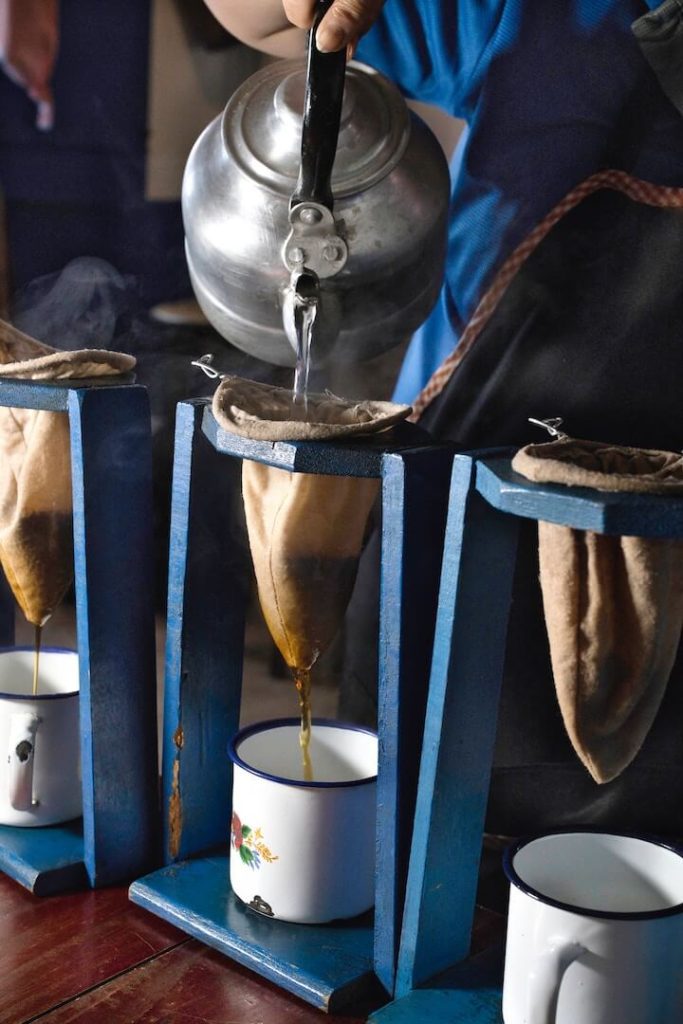
Is Tap Water in Costa Rica Safe to Drink?
In short — yes! The tap water is safe to drink in Costa Rica.
Bottled water is, of course, widely available and affordable throughout the country. So you can choose between refilling your own bottle or buying some from a convenience store.
When dining at restaurants, you can also ask for agua purificada (purified water) or agua en botella (bottled water) depending on your preference.

How Safe is the Street Food in Costa Rica?
Street food in Costa Rica is an integral part of the culinary landscape and is a delicious, affordable way to try local flavors. Look for stalls and carts that appear clean and have a steady stream of customers, as this indicates that the food is popular with locals and safe to eat!
Popular street food options include empanadas, which are savory pastries filled with meat or cheese, and patí — a savory Caribbean-inspired pastry pocket brimming with succulent meat, aromatic onions, pungent garlic, and a kick of spicy delight.
For fruit-based options, try street mango – available in plastic bags and seasoned with lime juice, salt, and optional chili flakes, this makes for a refreshing snack with a punch. Pejivalle is a popular street favorite, where vendors roast this peach-palm fruit to serve warm and salted.
Make sure to drink bottled water and use hand sanitizer before and after your meal. When in doubt, ask locals for their recommendations, as they can often point you to the tastiest and safest street food vendors.

What Type of Bread is Famous in Costa Rica?
Across Costa Rica, a popular bread is pan de maíz (cornbread). This simple loaf is made from cornmeal, giving it a slightly sweet, nutty flavor. It’s often served as a side dish with soups and stews, and some enjoy it with butter or a drizzle of honey for a snack.
Another popular bread item is tortillas — thin, unleavened flatbreads made from corn or wheat flour. This versatile bread is used to wrap ingredients for traditional dishes like tacos ticos or as a side to scoop up sauces and beans.
You may come across bollos — sweet, steamed corn cakes wrapped in banana leaves. These are typically enjoyed as a snack or breakfast treat. Pan casero is also a beloved homemade Costa Rican bread, known for its rustic charm and hearty flavor.

What Spices Are Commonly Used in Costa Rican Food?
Costa Rican cuisine boasts a delightful blend of flavors without overwhelming spiciness. Some of the spices and seasonings commonly used include:
Cilantro: This fragrant herb is a staple in Costa Rican cooking and adds a fresh, citrusy aroma to many dishes, especially gallo pinto and ceviche. Coriander and parsley are also popular.
Salsa Lizano: A condiment unique to Costa Rica, Salsa Lizano is a tangy, slightly sweet sauce made from vegetables, herbs, and spices. It’s often drizzled over rice, beans, and grilled meats.
Achiote: A natural red coloring derived from annatto seeds, achiote is used to season and color rice, soups, and stews.
Garlic and Onion: These basic seasonings form the foundation of many Costa Rican recipes, adding depth and flavor to dishes like “arroz con pollo” (chicken with rice).

While that brings our brief guide to typical Costa Rican food to a close, we hope you’re salivating at the potential dishes you can try on your vacation. From delicious street food to cheap and cheerful sodas, there are plenty of places to try local dishes in Costa Rica.
And if Jaco sounds like your kind of coastal haven, just drop us a line. From our Jaco adventure activities — including island hopping and ziplines in the treetops — to relaxing on the beach or getting a massage in Jaco, there are plenty of activities to enjoy in our hometown.
Don’t forget to let us know about your favorite Costa Rican dish on your adventure. Until next time, happy travels and happy eating!








